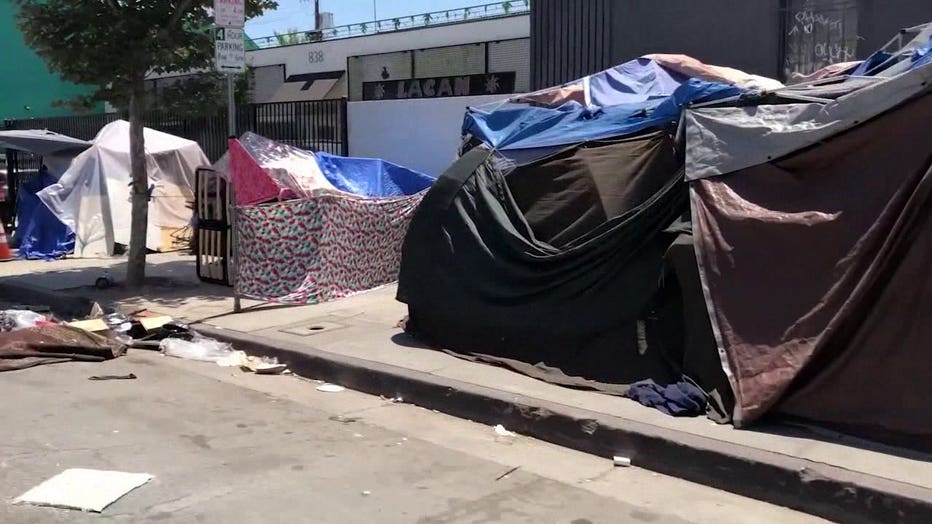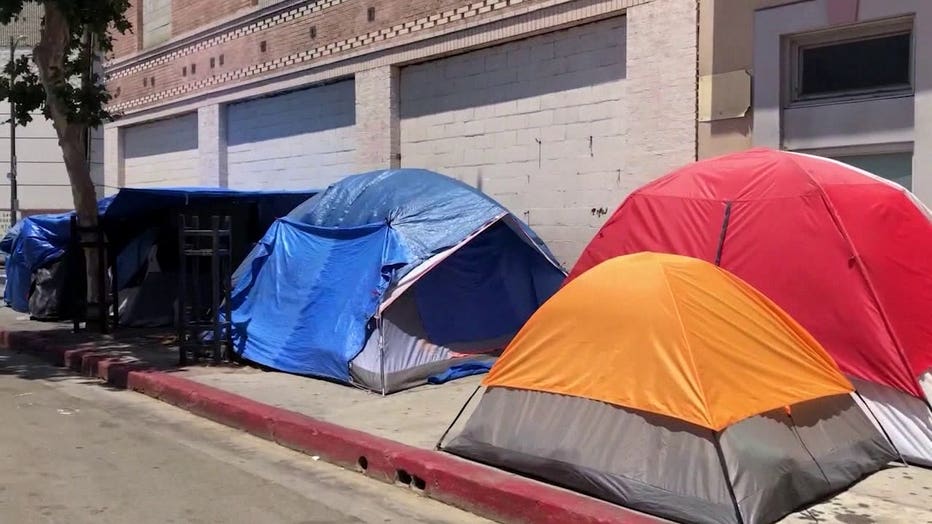LA City Council approves ban on homeless encampments in areas throughout city
Los Angeles City Council to restrict homeless encampments
The Los Angeles City Council has finalized an ordinance that would restrict the presence of encampments, as well as sitting, lying and sleeping, in several areas of the city, including within 500 feet of schools, daycare facilities, parks and libraries.
LOS ANGELES - The Los Angeles City Council has finalized an ordinance that will, if signed by Mayor Eric Garcetti, restrict the presence of encampments, as well as sitting, lying and sleeping, in several areas of the city, including within 500 feet of schools, daycare facilities, parks and libraries.
Thirteen council members voted to approve the ordinance on July 1, but with Councilman Mike Bonin and Councilwoman Nithya Raman dissenting, the ordinance fell short of the unanimous approval needed on its first consideration. On Wednesday, it will only need eight votes to pass.
The ordinance would prohibit sitting, sleeping, lying, storing personal property or otherwise obstructing the public right of way in several areas of the city, including within two feet of any fire hydrant or fire plug; within five feet of any operational or utilizable entrance or exit; within 10 feet of a loading dock or driveway; in a manner that interferes with any activity for which the city has issued a permit; in a manner that restricts accessible passage as required by the Americans with Disabilities Act; or anywhere within a street, including bike paths.
RELATED:
- LA City Council tentatively approves ordinance to restrict encampments
- LA City Council seeks new law to prevent homeless encampments in public areas

It would also protect the public right of way within 500 feet of a "sensitive" facility, including schools, daycare facilities, parks and libraries.
In explaining his decision to vote against the ordinance on July 1, Bonin shared with council members his own experience being unhoused, saying, "Some of those nights I slept in the car, some of those nights, when my car was in the shop, I slept on the beach. I cannot tell you how much turmoil is in your heart when the sun is setting and you don't know where to sleep. I cannot tell you how demoralizing and dehumanizing and defeating that experience is when you don't know where you're going to sleep."
Get your top stories delivered daily! Sign up for FOX 11’s Fast 5 newsletter. And, get breaking news alerts in the FOX 11 News app. Download for iOS or Android.
He said the ordinance tells people where they cannot sleep, but it doesn't tell them where they can sleep.
"That's what it comes down to for me ... where can people go, where can people sleep when they do not have an alternative," Bonin said.

He added that the Los Angeles Homeless Services Authority said Thursday that the city has only enough beds to shelter 39% of the city's homeless population.
The ordinance would also restrict blocking the public right of way once the Los Angeles City Council passes a resolution to do so, posts signage and gives notice in the following areas:
- up to 500 feet of a designated overpass, underpass, freeway ramp, tunnel, bridge, pedestrian bridge, subway, wash or spreading ground, railroad track or where lodging unsheltered or in tents is unhealthy, unsafe and incompatible with safe passage; and
- up to 1,000 feet of a facility opened after Jan. 1, 2018 that provides shelter, safe sleeping, safe parking or navigation centers for persons experiencing homelessness.
The ordinance would also allow the city to prevent encampments for a period of no longer than one year in areas that are deemed an ongoing threat to public health or safety, including due to:
- death or serious bodily injury of any person at the location due to a hazardous condition;
- repeated serious or violent crimes or threats of serious or violent crimes, including human trafficking; and fires at the location.
The council on June 29, when passing a motion to request the city attorney draft the ordinance, also instructed the city administrative officer to develop and implement a Street Engagement Strategy within 30 days to offer people suitable and available overnight shelter, interim or permanent housing.
The motion also instructed all relevant city departments to minimize engagement between law enforcement and people experiencing homelessness by:
- ensuring that service providers lead the Street Engagement Strategy and that people are offered interim or permanent housing services, treatment programs or other available interventions;
- deploying available alternative-to-policing models, including interventionists and experts in conflict resolution; and limiting law enforcement engagement to only where there is criminal behavior or activity and circumstances with a serious threat to public health or safety.
Several people called into the City Council meeting on July 1 to voice support and opposition for the ordinance.
Zachary Warma, legislative affairs manager for the Downtown Women's Center, said, "Implementing restrictions without first providing clarity as to how we are engaging unhoused residents and where they can ultimately go increases the odds of displacement, further traumatization, while putting housing and personal stability out of reach."
He asked the City Council to amend the ordinance to be contingent on developing "a robust street engagement strategy."
On Tuesday, the Our Future Los Angeles coalition called on the City Council to vote down the ordinance, saying "the criminalization of unhoused people has no place in L.A. We need to ensure everyone has access to safe and stable affordable housing."
Tune in to FOX 11 Los Angeles for the latest Southern California news.

